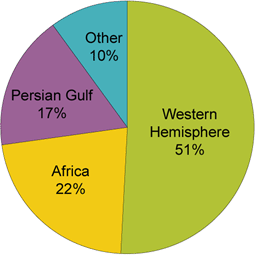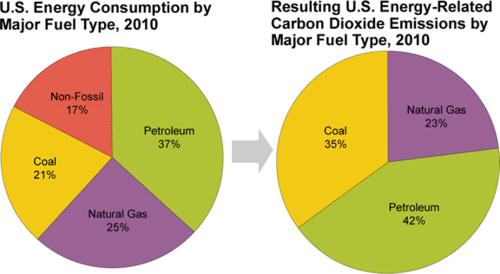14.1: Challenges and Impacts of Energy Use
- Page ID
- 27792
Introduction
Energy to illuminate, heat and cool our homes, businesses and institutions, manufacture products, and drive our transportation systems comes from a variety of sources that are originate from our planet and solar system. This provides a social and economic benefit to society. The earth’s core provides geothermal energy. The gravitational pull of moon and sun create tides. The sun makes power in multiple ways. By itself, the sun generates direct solar power. The sun’s radiation in combination with the hydrologic cycle can make wind power and hydroelectric power. Through photosynthesis, plants grow making wood and biomass that decay after they die into organic matter. Over the course of thousands of years, this decay results in fossil fuels that have concentrated or stored energy. Each of these types of energy can be defined as renewable or non-renewable fuels and they each have some environmental and health cost. Fossil fuel reserves are not distributed equally around the planet, nor are consumption and demand. We will see in this chapter that fuel distribution is critical to the sustainability of fossil fuel resources for a given geographic area. Making energy requires an input of energy so it is important to look at the net energy generated – the difference of the energy produced less the energy invested.
Environmental and Health Challenges of Energy Use
The environmental impacts of energy use on humans and the planet can happen anywhere during the life cycle of the energy source. The impacts begin with the extraction of the resource. They continue with the processing, purification or manufacture of the source, its transportation to place of energy generation, effects from the generation of energy including use of water, air, and land, and end with the disposal of waste generated during the process. Extraction of fossil fuels, especially as the more conventional sources are depleted, takes a high toll on the natural environment. As we mine deeper into mountains, further out at sea, or further into pristine habitats, we risk damaging fragile environments, and the results of accidents or natural disasters during extraction processes can be devastating. Fossils fuels are often located far from where they are utilized so they need to be transported by pipeline, tankers, rail or trucks. These all present the potential for accidents, leakage and spills. When transported by rail or truck energy must be expended and pollutants are generated. Processing of petroleum, gas and coal generates various types of emissions and wastes, as well as utilizes water resources. Production of energy at power plants results in air, water, and, often, waste emissions. Power plants are highly regulated in the Unites States by federal and state law under the Clean Air and Clean Water Acts, while nuclear power plants are regulated by the Nuclear Regulatory Commission. As long as the facilities are complying, much of the environmental impact is mitigated by treating the emissions and using proper waste disposal methods. However, from a sustainability perspective these still present environmental threats over the long run and have a complex variety of issues around them. Figure below summarizes these challenges.
 Figure \(\PageIndex{1}\): Environmental Impacts of Nonrenewable and Renewable Electricity Sources Source: C. Klein-Banai using data from U.S. Energy Information Administration and U.S. Environmental Protection Agency
Figure \(\PageIndex{1}\): Environmental Impacts of Nonrenewable and Renewable Electricity Sources Source: C. Klein-Banai using data from U.S. Energy Information Administration and U.S. Environmental Protection AgencyGeopolitical Challenges of Fossil Fuels
The use of fossil fuels has allowed much of the global population to reach a higher standard of living. However, this dependence on fossil fuels results in many significant impacts on society. Our modern technologies and services, such as transportation, landscaping, and plastics production depend in many ways on fossil fuels. Meaning, if supplies become limited or extremely costly, our economies are vulnerable. If countries do not have fossil fuel reserves of their own, they incur even more risk. The United States has become more and more dependent on foreign oil since 1970 when our own oil production peaked. The United States imported over half of the crude oil and refined petroleum products that we consumed during 2009. Just over half of these imports came from the Western Hemisphere (see Figure below).
 Figure \(\PageIndex{2}\): Sources of United States Net Petroleum Imports, 2009 Figure illustrates that the United States imported over half of the crude oil and refined petroleum products that it consumed during 2009. Source: U.S. Energy Information Administration, Petroleum Supply Annual, 2009, preliminary data.
Figure \(\PageIndex{2}\): Sources of United States Net Petroleum Imports, 2009 Figure illustrates that the United States imported over half of the crude oil and refined petroleum products that it consumed during 2009. Source: U.S. Energy Information Administration, Petroleum Supply Annual, 2009, preliminary data.The holder of oil reserves in the oil market is the Organization of Petroleum Exporting Countries, (OPEC) (see Figure below). As of January 2009, there were 12 member countries in OPEC: Algeria, Angola, Ecuador, Iran, Iraq, Kuwait, Libya, Nigeria, Qatar, Saudi Arabia, the United Arab Emirates, and Venezuela. OPEC attempts to influence the amount of oil available to the world by assigning a production quota to each member except Iraq, for which no quota is presently set. Overall compliance with these quotas is mixed since the individual countries make the actual production decisions. All of these countries have a national oil company but also allow international oil companies to operate within their borders. They can restrict the amounts of production by those oil companies. Therefore, the OPEC countries have a large influence on how much of world demand is met by OPEC and non-OPEC supply. A recent example of this is the price increases that occurred during the year 2011 after multiple popular uprisings in Arab countries, including Libya.
 Figure \(\PageIndex{3}\): Proven Oil Reserves Holders Pie chart shows proven oil reserves holders. Source: C. Klein-Banai using data from BP Statistical Review of World Energy (2010)
Figure \(\PageIndex{3}\): Proven Oil Reserves Holders Pie chart shows proven oil reserves holders. Source: C. Klein-Banai using data from BP Statistical Review of World Energy (2010)This pressure has lead the United States to developing policies that would reduce reliance on foreign oil such as developing additional domestic sources and obtaining it from non-Middle Eastern countries such as Canada, Mexico, Venezuela, and Nigeria. However, since fossil fuel reserves create jobs and provide dividends to investors, a lot is at stake in a nation that has these reserves. Depending on whether that oil wealth is shared with the country’s inhabitants or retained by the oil companies and dictatorships, as in Nigeria prior to the 1990s, a nation with fossil fuel reserves may benefit or come out even worse.
Nonrenewable Energy and the Environment
Fossil fuels are also known as non-renewable energy because it takes thousands of years for the earth to regenerate them. The three main fuel sources come in all phases – solid, liquid, and gas. One overriding concern is the carbon dioxide emissions that contribute to climate change. Figure below displays the relationship between fuel type and carbon emissions.
 Figure \(\PageIndex{4}\): Fuel Type and Carbon Emissions The two charts show the relationship between fuel type and carbon emissions for U.S. energy consumption in 2010. Source: U.S. Energy Information Administration
Figure \(\PageIndex{4}\): Fuel Type and Carbon Emissions The two charts show the relationship between fuel type and carbon emissions for U.S. energy consumption in 2010. Source: U.S. Energy Information Administration
